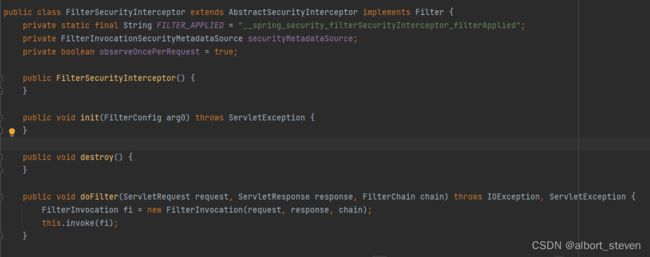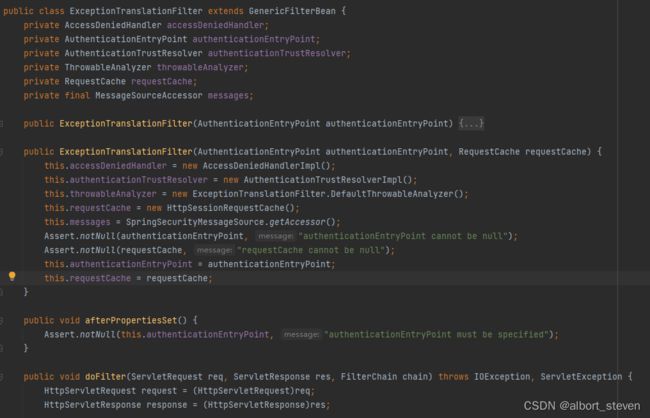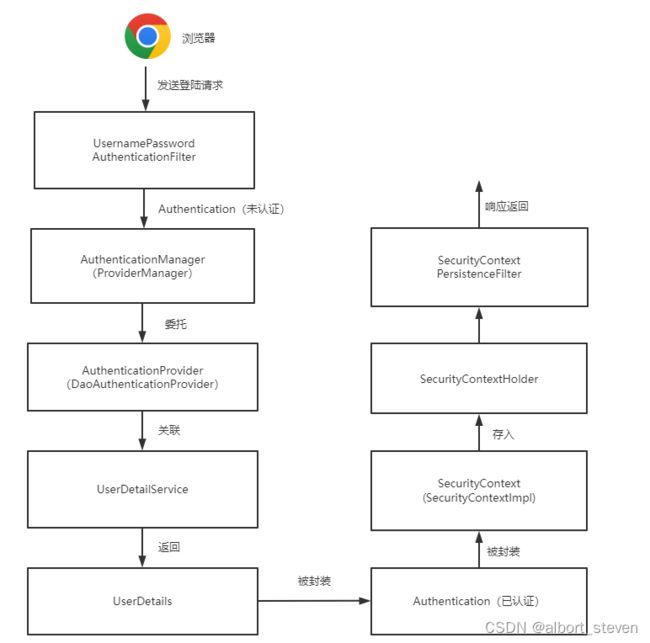Spring Security底层源码剖析
过滤器链中三个较为重要的过滤器
FilterSecurityInterceptor:是一个方法级别的权限过滤器,基本位于过滤链的最底层。
ExceptionTranslationFilter:是个异常过滤器,用来处理在认证授权过程中抛出的异常。
UsernamePasswordAuthenticationFilter:对/login的POST请求做拦截,校验表单中用户名,密码。
过滤器如何进行加载的?
使用Spring Security配置过滤器
-
DelegatingFilterProxy
public void doFilter(ServletRequest request, ServletResponse response, FilterChain filterChain) throws ServletException, IOException {
Filter delegateToUse = this.delegate;
if (delegateToUse == null) {
synchronized(this.delegateMonitor) {
delegateToUse = this.delegate;
if (delegateToUse == null) {
WebApplicationContext wac = this.findWebApplicationContext();
if (wac == null) {
throw new IllegalStateException("No WebApplicationContext found: no ContextLoaderListener or DispatcherServlet registered?");
}
delegateToUse = this.initDelegate(wac);
}
this.delegate = delegateToUse;
}
}
this.invokeDelegate(delegateToUse, request, response, filterChain);
}
protected Filter initDelegate(WebApplicationContext wac) throws ServletException {
String targetBeanName = this.getTargetBeanName();//得到的BeanName就是FilterChainProxy
Assert.state(targetBeanName != null, "No target bean name set");
Filter delegate = (Filter)wac.getBean(targetBeanName, Filter.class);
if (this.isTargetFilterLifecycle()) {
delegate.init(this.getFilterConfig());
}
return delegate;
}-
FilterChainProxy
private void doFilterInternal(ServletRequest request, ServletResponse response, FilterChain chain) throws IOException, ServletException {
FirewalledRequest fwRequest = this.firewall.getFirewalledRequest((HttpServletRequest)request);
HttpServletResponse fwResponse = this.firewall.getFirewalledResponse((HttpServletResponse)response);
List filters = this.getFilters((HttpServletRequest)fwRequest);
if (filters != null && filters.size() != 0) {
FilterChainProxy.VirtualFilterChain vfc = new FilterChainProxy.VirtualFilterChain(fwRequest, chain, filters);
vfc.doFilter(fwRequest, fwResponse);
} else {
if (logger.isDebugEnabled()) {
logger.debug(UrlUtils.buildRequestUrl(fwRequest) + (filters == null ? " has no matching filters" : " has an empty filter list"));
}
fwRequest.reset();
chain.doFilter(fwRequest, fwResponse);
}
}
private List getFilters(HttpServletRequest request) {
Iterator var2 = this.filterChains.iterator();
SecurityFilterChain chain;
do {
if (!var2.hasNext()) {
return null;
}
chain = (SecurityFilterChain)var2.next();
} while(!chain.matches(request));
return chain.getFilters();
} 两个重要的接口
-
UserDetailService 接口:查询数据库用户名和密码
public interface UserDetailsService {
UserDetails loadUserByUsername(String var1) throws UsernameNotFoundException;
}
public interface UserDetails extends Serializable {
Collection getAuthorities();
String getPassword();//获取密码
String getUsername();//获取账号
boolean isAccountNonExpired();
boolean isAccountNonLocked();
boolean isCredentialsNonExpired();
boolean isEnabled();
}-
PasswordEncoder 接口:密码加密接口,用于返回User对象里面密码加密
比较常用BCryptPasswordEncoder,对一个密码进行加密,多次加密结果返回均不一致。
public interface PasswordEncoder {
String encode(CharSequence var1);
boolean matches(CharSequence var1, String var2);
}
public class BCryptPasswordEncoder implements PasswordEncoder {
private Pattern BCRYPT_PATTERN;
private final Log logger;
private final int strength;
private final SecureRandom random;
public BCryptPasswordEncoder() {
this(-1);
}
public BCryptPasswordEncoder(int strength) {
this(strength, (SecureRandom)null);
}
public BCryptPasswordEncoder(int strength, SecureRandom random) {
this.BCRYPT_PATTERN = Pattern.compile("\\A\\$2a?\\$\\d\\d\\$[./0-9A-Za-z]{53}");
this.logger = LogFactory.getLog(this.getClass());
if (strength == -1 || strength >= 4 && strength <= 31) {
this.strength = strength;
this.random = random;
} else {
throw new IllegalArgumentException("Bad strength");
}
}
public String encode(CharSequence rawPassword) {
String salt;
if (this.strength > 0) {
if (this.random != null) {
salt = BCrypt.gensalt(this.strength, this.random);
} else {
salt = BCrypt.gensalt(this.strength);
}
} else {
salt = BCrypt.gensalt();
}
return BCrypt.hashpw(rawPassword.toString(), salt);
}
public boolean matches(CharSequence rawPassword, String encodedPassword) {
if (encodedPassword != null && encodedPassword.length() != 0) {
if (!this.BCRYPT_PATTERN.matcher(encodedPassword).matches()) {
this.logger.warn("Encoded password does not look like BCrypt");
return false;
} else {
return BCrypt.checkpw(rawPassword.toString(), encodedPassword);
}
} else {
this.logger.warn("Empty encoded password");
return false;
}
}
}登陆认证总体框架图
认证流程
查看UsernamePasswordAuthenticationFilter过滤器,发现其继承了AbstractAuthenticationProcessingFilter。
查看父类中的doFilter方法
如果是POST请求就进行认证,如果不是就放行。
调用子类中的attemptAuthentication方法,进行身份的认证。认证成功之后,将对象的信息封装到Authentication对象中。
public Authentication attemptAuthentication(HttpServletRequest request, HttpServletResponse response) throws AuthenticationException {
//判断是否是POST提交
if (this.postOnly && !request.getMethod().equals("POST")) {
throw new AuthenticationServiceException("Authentication method not supported: " + request.getMethod());
} else {
//获取表单提交过来的数据
String username = this.obtainUsername(request);
String password = this.obtainPassword(request);
if (username == null) {
username = "";
}
if (password == null) {
password = "";
}
//去除用户名两端空格
username = username.trim();
//使用获取到的数据,构造成token对象,标记为未认证
UsernamePasswordAuthenticationToken authRequest = new UsernamePasswordAuthenticationToken(username, password);
//将请求中的一些属性信息设置到对象中
this.setDetails(request, authRequest);
//调用方法进行身份认证(我们自定义的UserDetailsService)
return this.getAuthenticationManager().authenticate(authRequest);
}
}查看UsernamePasswordAuthenticationToken 源码
public class UsernamePasswordAuthenticationToken extends AbstractAuthenticationToken {
private static final long serialVersionUID = 500L;
private final Object principal;//账号
private Object credentials;//密码
//未认证方法
public UsernamePasswordAuthenticationToken(Object principal, Object credentials) {
super((Collection)null);
this.principal = principal;
this.credentials = credentials;
this.setAuthenticated(false);//设置是否被认证,false表示是未认证,true表示已认证
}
//已认证方法
public UsernamePasswordAuthenticationToken(Object principal, Object credentials, Collection authorities) {
super(authorities);
this.principal = principal;
this.credentials = credentials;
super.setAuthenticated(true);
}查看AuthenticationManager及其实现类ProviderManager源码
public interface AuthenticationManager {
Authentication authenticate(Authentication var1) throws AuthenticationException;
}
public class ProviderManager implements AuthenticationManager, MessageSourceAware, InitializingBean {
public Authentication authenticate(Authentication authentication) throws AuthenticationException {
Class toTest = authentication.getClass();//得到传进来的类型,即UsernamePasswordAuthenticationToken.class
AuthenticationException lastException = null;
Authentication result = null;
boolean debug = logger.isDebugEnabled();
Iterator var6 = this.getProviders().iterator();//迭代器迭代
while(var6.hasNext()) {
AuthenticationProvider provider = (AuthenticationProvider)var6.next();
//判断当前AuthenticationProvider是否适用UsernamePasswordAuthenticationToken.class类型的Authentication
if (provider.supports(toTest)) {
if (debug) {
logger.debug("Authentication attempt using " + provider.getClass().getName());
}
//成功找到适配当前认证方式的AuthenticationProvider,此处为DaoAuthenticationProvider
try {
//调用DaoAuthenticationProvider的authenticate()方法进行认证,如果认证成功,会返回一个标记已认证的Authentication对象
result = provider.authenticate(authentication);
//认证成功后,将传入的Authentication对象中的details信息拷贝到已认证的Authentication对象中
if (result != null) {
this.copyDetails(authentication, result);
break;
}
} catch (AccountStatusException var11) {
this.prepareException(var11, authentication);
throw var11;
} catch (InternalAuthenticationServiceException var12) {
this.prepareException(var12, authentication);
throw var12;
} catch (AuthenticationException var13) {
lastException = var13;
}
}
}
if (result == null && this.parent != null) {
try {
result = this.parent.authenticate(authentication);
} catch (ProviderNotFoundException var9) {
} catch (AuthenticationException var10) {
lastException = var10;
}
}
if (result != null) {
//认证成功之后,去除result的敏感信息,要求相关类实现CredentialsContainer接口
if (this.eraseCredentialsAfterAuthentication && result instanceof CredentialsContainer) {
//去除过程就是调用CredentialsContainer接口的eraseCredentials()方法
((CredentialsContainer)result).eraseCredentials();
}
//发布认证成功事件
this.eventPublisher.publishAuthenticationSuccess(result);
return result;
} else {
//认证失败,抛出失败的异常信息
if (lastException == null) {
lastException = new ProviderNotFoundException(this.messages.getMessage("ProviderManager.providerNotFound", new Object[]{toTest.getName()}, "No AuthenticationProvider found for {0}"));
}
this.prepareException((AuthenticationException)lastException, authentication);
throw lastException;
}
}
}继续查看doFilter方法
配置会话策略。
若验证失败执行验证失败的方法。
验证成功执行成功方法。
查看验证成功和验证失败方法源码
protected void successfulAuthentication(HttpServletRequest request, HttpServletResponse response, FilterChain chain, Authentication authResult) throws IOException, ServletException {
if (this.logger.isDebugEnabled()) {
this.logger.debug("Authentication success. Updating SecurityContextHolder to contain: " + authResult);
}
SecurityContextHolder.getContext().setAuthentication(authResult);
this.rememberMeServices.loginSuccess(request, response, authResult);
if (this.eventPublisher != null) {
this.eventPublisher.publishEvent(new InteractiveAuthenticationSuccessEvent(authResult, this.getClass()));
}
this.successHandler.onAuthenticationSuccess(request, response, authResult);
}
protected void unsuccessfulAuthentication(HttpServletRequest request, HttpServletResponse response, AuthenticationException failed) throws IOException, ServletException {
SecurityContextHolder.clearContext();
if (this.logger.isDebugEnabled()) {
this.logger.debug("Authentication request failed: " + failed.toString(), failed);
this.logger.debug("Updated SecurityContextHolder to contain null Authentication");
this.logger.debug("Delegating to authentication failure handler " + this.failureHandler);
}
this.rememberMeServices.loginFail(request, response);
this.failureHandler.onAuthenticationFailure(request, response, failed);
}权限访问流程
查看ExceptionTranslationFilter源码
public class ExceptionTranslationFilter extends GenericFilterBean {
public void doFilter(ServletRequest req, ServletResponse res, FilterChain chain) throws IOException, ServletException {
HttpServletRequest request = (HttpServletRequest)req;
HttpServletResponse response = (HttpServletResponse)res;
try {
chain.doFilter(request, response);
this.logger.debug("Chain processed normally");
} catch (IOException var9) {
throw var9;
} catch (Exception var10) {
Throwable[] causeChain = this.throwableAnalyzer.determineCauseChain(var10);
RuntimeException ase = (AuthenticationException)this.throwableAnalyzer.getFirstThrowableOfType(AuthenticationException.class, causeChain);
if (ase == null) {
ase = (AccessDeniedException)this.throwableAnalyzer.getFirstThrowableOfType(AccessDeniedException.class, causeChain);
}
if (ase == null) {
if (var10 instanceof ServletException) {
throw (ServletException)var10;
}
if (var10 instanceof RuntimeException) {
throw (RuntimeException)var10;
}
throw new RuntimeException(var10);
}
if (response.isCommitted()) {
throw new ServletException("Unable to handle the Spring Security Exception because the response is already committed.", var10);
}
this.handleSpringSecurityException(request, response, chain, (RuntimeException)ase);
}
}
}主要功能就是对前端请求直接放行,如果抛出异常,对相应的异常进行捕获并处理。
查看FilterSecurityInterceptor源码
public class FilterSecurityInterceptor extends AbstractSecurityInterceptor implements Filter {
private static final String FILTER_APPLIED = "__spring_security_filterSecurityInterceptor_filterApplied";
private FilterInvocationSecurityMetadataSource securityMetadataSource;
private boolean observeOncePerRequest = true;
public void doFilter(ServletRequest request, ServletResponse response, FilterChain chain) throws IOException, ServletException {
FilterInvocation fi = new FilterInvocation(request, response, chain);
this.invoke(fi);
}
public void invoke(FilterInvocation fi) throws IOException, ServletException {
if (fi.getRequest() != null && fi.getRequest().getAttribute("__spring_security_filterSecurityInterceptor_filterApplied") != null && this.observeOncePerRequest) {
fi.getChain().doFilter(fi.getRequest(), fi.getResponse());
} else {
if (fi.getRequest() != null && this.observeOncePerRequest) {
fi.getRequest().setAttribute("__spring_security_filterSecurityInterceptor_filterApplied", Boolean.TRUE);
}
//判断请求是否有权限
InterceptorStatusToken token = super.beforeInvocation(fi);
try {
//进行SpringMvc处理
fi.getChain().doFilter(fi.getRequest(), fi.getResponse());
} finally {
super.finallyInvocation(token);
}
super.afterInvocation(token, (Object)null);
}
}
}位于过滤器链的最底层,主要功能是根据资源权限来判断当前请求是否能访问当前资源。
请求间认证共享
认证成功的方法,把认证信息对象,封装到SecurityContext里面,存入SecurityContextHolder里面
查看SecurityContext源码
public interface SecurityContext extends Serializable {
Authentication getAuthentication();
void setAuthentication(Authentication var1);
}
public class SecurityContextImpl implements SecurityContext {
private static final long serialVersionUID = 500L;
private Authentication authentication;
public SecurityContextImpl() {
}
public SecurityContextImpl(Authentication authentication) {
this.authentication = authentication;
}
}查看SecurityContextHolder源码
public class SecurityContextHolder {
public static final String MODE_THREADLOCAL = "MODE_THREADLOCAL";
public static final String MODE_INHERITABLETHREADLOCAL = "MODE_INHERITABLETHREADLOCAL";
public static final String MODE_GLOBAL = "MODE_GLOBAL";
public static final String SYSTEM_PROPERTY = "spring.security.strategy";
private static String strategyName = System.getProperty("spring.security.strategy");
private static SecurityContextHolderStrategy strategy;
private static int initializeCount = 0;
/*
public SecurityContext getContext() {
SecurityContext ctx = (SecurityContext)contextHolder.get();
if (ctx == null) {
ctx = this.createEmptyContext();
contextHolder.set(ctx);
}
return ctx;
}
*/
//如果没有SecurityContext就创建一个
public static SecurityContext getContext() {
return strategy.getContext();
}
//使用ThreadLocal进行操作
private static void initialize() {
if (!StringUtils.hasText(strategyName)) {
strategyName = "MODE_THREADLOCAL";
}
if (strategyName.equals("MODE_THREADLOCAL")) {
strategy = new ThreadLocalSecurityContextHolderStrategy();
} else if (strategyName.equals("MODE_INHERITABLETHREADLOCAL")) {
strategy = new InheritableThreadLocalSecurityContextHolderStrategy();
} else if (strategyName.equals("MODE_GLOBAL")) {
strategy = new GlobalSecurityContextHolderStrategy();
} else {
try {
Class clazz = Class.forName(strategyName);
Constructor customStrategy = clazz.getConstructor();
strategy = (SecurityContextHolderStrategy)customStrategy.newInstance();
} catch (Exception var2) {
ReflectionUtils.handleReflectionException(var2);
}
}
++initializeCount;
}
}
查看SecurityContextPersistenceFilter源码
public class SecurityContextPersistenceFilter extends GenericFilterBean {
static final String FILTER_APPLIED = "__spring_security_scpf_applied";
private SecurityContextRepository repo;
private boolean forceEagerSessionCreation;
public void doFilter(ServletRequest req, ServletResponse res, FilterChain chain) throws IOException, ServletException {
HttpServletRequest request = (HttpServletRequest)req;
HttpServletResponse response = (HttpServletResponse)res;
if (request.getAttribute("__spring_security_scpf_applied") != null) {
chain.doFilter(request, response);
} else {
boolean debug = this.logger.isDebugEnabled();
request.setAttribute("__spring_security_scpf_applied", Boolean.TRUE);
if (this.forceEagerSessionCreation) {
HttpSession session = request.getSession();
if (debug && session.isNew()) {
this.logger.debug("Eagerly created session: " + session.getId());
}
}
HttpRequestResponseHolder holder = new HttpRequestResponseHolder(request, response);
SecurityContext contextBeforeChainExecution = this.repo.loadContext(holder);
boolean var13 = false;
try {
var13 = true;
SecurityContextHolder.setContext(contextBeforeChainExecution);
chain.doFilter(holder.getRequest(), holder.getResponse());
var13 = false;
} finally {
if (var13) {
SecurityContext contextAfterChainExecution = SecurityContextHolder.getContext();
SecurityContextHolder.clearContext();
this.repo.saveContext(contextAfterChainExecution, holder.getRequest(), holder.getResponse());
request.removeAttribute("__spring_security_scpf_applied");
if (debug) {
this.logger.debug("SecurityContextHolder now cleared, as request processing completed");
}
}
}
SecurityContext contextAfterChainExecution = SecurityContextHolder.getContext();
SecurityContextHolder.clearContext();
this.repo.saveContext(contextAfterChainExecution, holder.getRequest(), holder.getResponse());
request.removeAttribute("__spring_security_scpf_applied");
if (debug) {
this.logger.debug("SecurityContextHolder now cleared, as request processing completed");
}
}
}
}方法中大体意思是看session中是否存在SecurityContext对象,如果有直接返回,如果没有则创建一个新的对象。将SecurityContext放入SecurityContextHolder中,执行后续过滤器。执行完毕之后,从SecurityContextHolder中将SecurityContext取出来,将之前的SecurityContext移除,再将数据存入session中。











